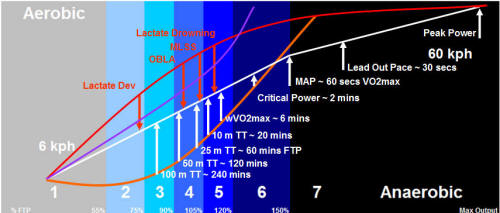ATL CTL & TSB ~ Quality & Quantity...
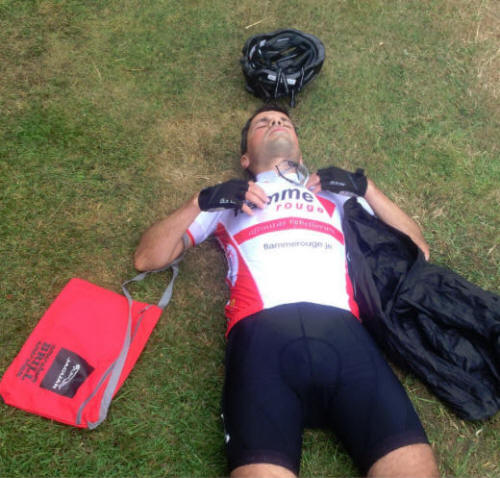
Too much workload in one hit can leave you
a little fatigued...
David de Sousa ~ recovering from a
sportive with his brother!
With the explosion of the availability of "affordable" power meters in the last few years, and the software to analyse their output, a lot of confusion has arisen surrounding some of the terms used, what they mean and how they apply to the real world.
This is a BIG subject, but hopefully we can clear some of these issues in this slightly lengthy, but just scratching the surface, factsheet!
Performance Management Chart
As you know, I love triangulation. Never take anything, ever,
at face value. Corroborate everything with at least two
cross-referenced facts to support your initial premise. Otherwise
all you have is an opinion.
Fitness, means nothing without understanding how that fitness was achieved, in what time frame and at what physiological cost. So let's take a look at the ethereal, muddy waters of fitness and the things you need to triangulate to make sense of all this Training Peaks-led power tomfoolery.
The same chart appears in WKO software and a similar one is used in Strava (premium) & Golden Cheetah.
We start with the Performance Management Chart...
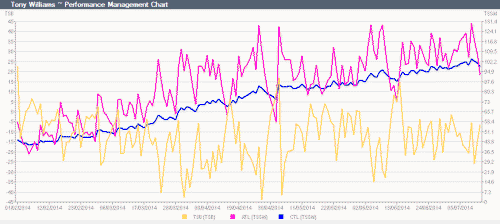
As perfect a (blue) fitness build as it can be
do the right
things, in the right order...
Above is my Performance Management Chart (PMC) for the 2014-2015 season. A little hiatus in April to re-charge the batteries post-Flanders, can clearly be seen in the middle of the chart.
This is the chart that gives you the "big-picture". You need
to drill down in to the data to make sense of the squiggly lines to
know when up is good and down is bad; and vice-versa.
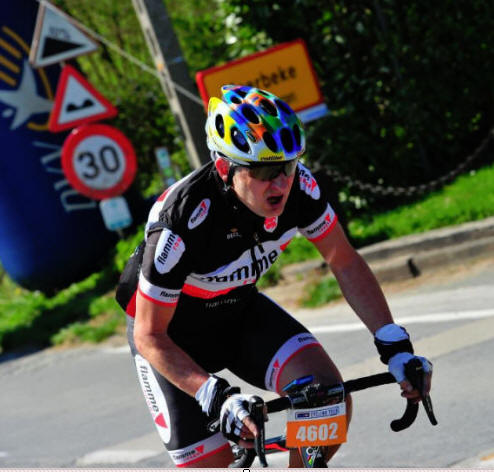
clearing the mighty Flandrian Bosberg
screaming legs, burning
lungs, inducing stress (not my best look)...
Training Stress Score ~ TSS
Every time you actively ride your bike you reactively create a
training load that stresses the body to a greater or lesser extent.
With the advent of power meters we can accurately allocate numbers to the induced physical load (Training Stress Score) and the subsequently created physiological stress (Training Stress Balance). Once we have these metrics we can do some really clever things with them.
Ride to a high enough level and you will elicit a measurable training response from your body. Ride at a low enough level and it's not training it's recovery. Recovery is a vital part of the training process, but we'll come to that later.
An individual session's training load is relative to your current level of fitness. If you were to ride for an hour as hard as you could (our baseline reference point known as Functional Threshold Power ~ FTP), you would create a training stress score of 100, at an intensity factor of 1.0. Which is, in effect, 100% hardness!
It doesn't matter if your FTP for that hour was 200, 300 or 400 watts. You did your best, so it scores 100 TSS points.
This ever-changing baseline is the constant comparator against which all subsequent training sessions and drills are measured.
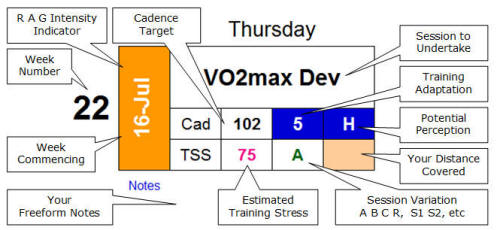
An explanation of a session descriptor
from one of our programmes
You can see above (in red), that our VO2max Development session gives an (estimated) TSS of 75 points.
It is 75% as hard as a one hour flat out ride. The "efforts" are ridden at above FTP wattage, but the warm-up and cool down are ridden at significantly less than this.
All in all, you score (and bank) around 75 TSS points for this session. We can't be exact, because we can't control the length and/or intensity of the warm up and cool down. We can only estimate on given norms.
It doesn't matter if it's you, me, my mum or Peter Sagan, a VO2max Dev session, even though our power outputs would be hugely different, will give us all the exact same "relative" training stress score of 75 points.
If you do it in March at 250 watts or do it in July at 280 watts, you still only score 75 points, because the score is relative to your state of fitness at the time of undertaking.
Training Stress Score is a standalone, discreet number.

Our programme's weekly cumulative TSS is
displayed in the tan box on the far right
This is from the Classics Roubaix Programme
Do two or three mid week sessions, a weekend endurance ride, and a weekend recovery ride and you can add all those numbers up to give you your weekly training stress score. This contributes to your rolling, calculated TSS, your Acute Training Load...
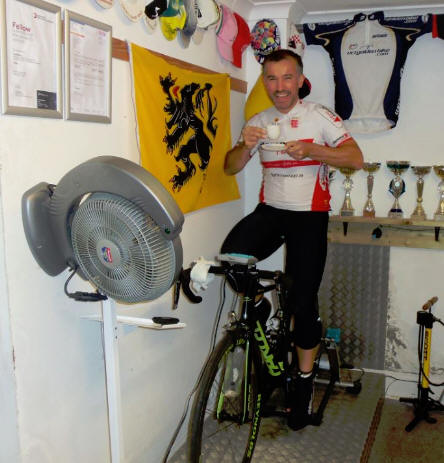
George de
Sousa
prepping for an application of training load to help
smash his brother Dave!
Acute Training Load ~ ATL
Acute Training Load is the pink line in the chart
below, and is displayed as a TSS/d. ATL is your
near-time
training load, that is tracked (usually) over a rolling seven day period.
Which is why it's very "jumpy".

At the far left of the chart, we start our slow transition to full fitness. We give the body a slight physical overload (pink), causing a slight training response (blue) which brings about a slight level of fatigue (yellow).
We begin the training season with an aerobic base fitness build consisting of a structured, progressive, low weekly overload. For a "normal" rider, this will be around the 300 - 350 TSS points per week, which averages around 50 points per day.
As time moves on, we need to apply a progressively greater training load to bring about a continued increase in adaptation and a progressive, sustainable improvement in fitness.

You can see from this Classics Roubaix Programme screenshot, that training load ramps up to 665 TSS points in the final training week of this eight week programme.
This is almost double that of the initial week of our Base Build Programme. This level of load would be unsustainable in the early weeks of our training, it has to be built up to slowly and steadily.
Acute Training Load is actually an exponentially weighted rolling average of the work you undertook over the last week. The work you did yesterday contributing more to the running total than work you did seven days ago.
Acute Training Load is a relative time-based number dependent upon the cumulative workload you have recently undertaken.
It is still displayed as a TSS, but now it has a "/d" suffix, which changes it to a perceived daily workload spread over the preceding seven days.
Here is my weekly workload for the second red week of our Base Build Programme, in the run up to Christmas 2015; at 119 TSS/d it's a tadge fatiguing! But the main thing is it's just sustainable and I'm about to get a Grey (adaptation) Week before we continue the build in the New Year.
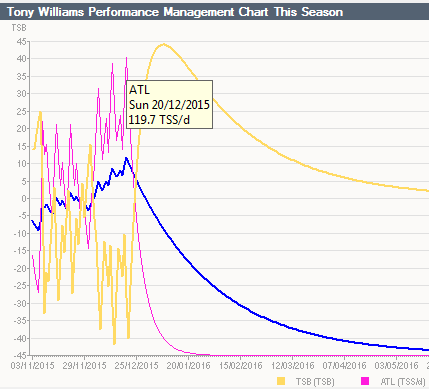
Although I haven't done so, and probably couldn't, this workload equates to doing more than a full-on 25 mile TT every day for a week. Which as you would guess would make us very, very, fatigued.
ATL takes no consideration of the type of training you've undertaken, it only records the total workload. We'll come to composition a little later.
As our good engineering friend Isaac Newton told us, for every action, there is an equal and opposite reaction.
Just as we can track workload, we can track direct levels of fatigue caused by that workload.
This our Training Stress Balance.

The Climbageddons can be somewhat fatiguing
Road Captain Mick Heald and the comfort of underfloor
heating...
Training Stress Balance ~ TSB
Training Stress Balance is the price you have to pay for the
training load you have applied to yourself over any given period.
It's a very simple concept; you train you get tired. The more you train, the more tired you get. And we all have a breaking point.
Remember this above all else. You only actually get stronger when you stop training to allow your body to recover and adapt.
A tired rider can not train as well as a fresh rider. Most riders think that if they are not training they are losing fitness. So there is this constant juggling act going on between the training angel and the recovery devil (or is it the other way around?). One is telling you to get on your bike, the other to stay on the couch!
If you are not training, you are not necessarily losing fitness, you are actually gaining freshness. Finding the fitness/freshness balance that is right for you is the key to progression and success.
You can see in the above Performance Management Chart, from the ATL (weekly) figure for Sunday 20th December, I'd applied a projected training load of 119 TSS points per day for that week.
On Saturday morning, before my weekend ride, I had a TSB (fatigue) level of minus 10.3 points. You can see this in the same chart shown below.
Minus 10.3 was the effective cumulative fatigue my mid-week sessions had created to that point. This is a nice manageable level of fatigue!
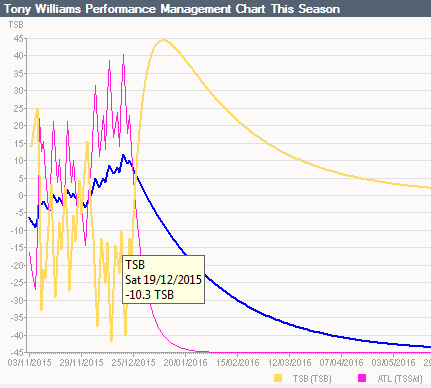
Saturday and Sunday were our seemingly easy "undulating rides", where we ride smallish hills, over-geared and with a low cadence.
On paper they look a doddle and are fired off at an average speed of just 25 kph. When you set out you think you are in for an easy morning. When you get home, you know you've done a ride; a proper ride.
The chart below shows the subsequent fatigue level induced after the weekend undulating rides, which is why it has a Monday date.
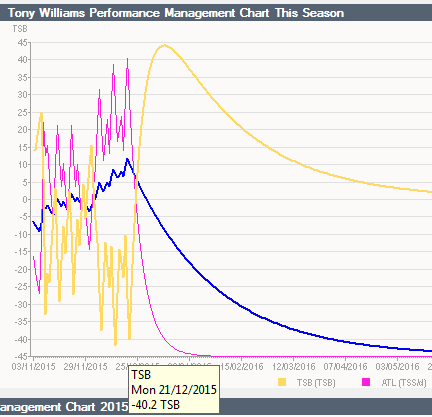
Above we saw that the seven days previous had left me with a fatigue level of minus 10.3.
We can now see that for the last rolling seven day, including the "undulating" Saturday and Sunday, it has now gone to minus 40.
Those two undulating over-geared, muscle tension, leg-snapping days, have replaced those of the previous weekend's rides.
Which were only about 10 kms shorter, but had less of an overall fatigue contributory factor, as they were further away in time. Obviously yesterday's rides are going to have more of an adverse effect on me than last weeks.
Training Stress Balance is derived from the current Chronic Training Load (see below), minus the current Acute Training Load and is again displayed as a discrete number.
TSB is good for showing us how fatigued we are over a long period of time, as we can check the overall figure, and the figures leading up to it, to give us an indication of trends. Always pay attention to trends.
Although the fact you can't stay awake in the afternoons and your legs constantly hurt is another good indicator. We used to use this simple information feedback loop before these new-fangled systems came along!
One of the good short-term things TSB can be used for is to give you an indication of how many rest days you should take. If it's minus 10, then you are probably good to go. If it's minus 40, maybe you should take two rest days before kicking off again.
Learn the numbers that work best for you, and set your training/recovery strategy accordingly. Your main aim is to feel pleasantly fatigued most of the time and just short of jaded at the end of a red week.
After your grey recovery and adaptation week you should be all fired up to go again. If you're not, take a few more days recovery.
As you come up to your main objectives of the season, it would be nice to have a positive TSB number, although you can be "too recovered".
Single digits, either side of zero is a good place to be. As long as our third triangulation point is in the right place, that of Chronic Training Load...
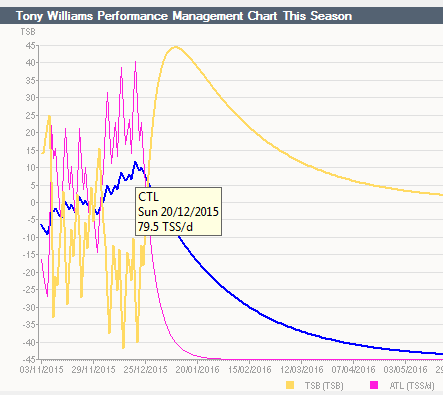
Chronic Training Load ~ CTL
Here we have the third metric in our triangulation process, and
arguably the most important.
CTL is the long-term training load which is normally calculated over an exponentially weighted, 42 day, rolling average.
Which means, even today, the training load you applied up to forty-two days ago is still making a contribution to your overall fitness. Although obviously, less of a one than the training you did last week.
To keep the CTL moving upwards you have to ensure the workload you applied this week was greater than that of last week. Because last week you got stronger due to the workload you applied the week before that!
You can not just keep going out and doing the same thing over and over again and hope to get fitter. At best you'll plateau. There HAS TO BE constant overload to progress.
So riding say 2 x 20 minute efforts at 250 watts for 12 weeks through the winter, will not increase your CTL. You will gain a fitness of sorts, but nothing that will help you ride above 250 watts for 20 minutes!
Again, there has to be moderation in everything. Controlled, progressive overload is the way your body responds best. Managing the rise of your CTL is the key to having a good season. Too quickly you'll suffer burnout. Too slowly, you won't be ready for your key objectives.
A weekly CTL rise of 4 to 7 points is optimum, and sustainable, for most riders. Elites and pros can get away with 8-10. Because they have more time to recover during their "working day".
They also have "underneath them" much more of a mainly aerobic base training load to be able to support such rapid rises in fitness.
For mortals, it's everyday life that gets in our way of potential stardom. While you are working, the pros are building their aerobic base. For a "normal" rider, like us, a CTL of 100 is a "good score"; increasing it by more than five a week is impressive and very hard to sustain.
A Grand Tour rider will be looking to start their event with a CTL of around 150 TSS/d. This will probably build to around 200 points at the end of their twenty-one day ordeal. Bringing a 50 point increase in CTL over three weeks, or 17 points per week.
A rider like us might "just" be able to sustain a weekly load of 700 TSS points for a couple of weeks or so.
Grand Tour riders, even the Lantern Rouge at the back, will hit around 1600-1700 points per week, for three successive weeks. They really are that hard!
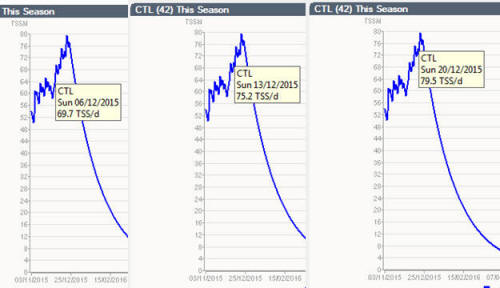
The above, CTL-only montage, is a three-week period from the headline PMC chart at the top of the page. It shows my controlled, progressive and sustainable lead up to December's Red Week.
You can clearly see from the November start (far left), three weeks on, one week off (the dip), three weeks on. As I type, I'm in the middle of my Christmas week off. Recovering and harvesting energy for the forthcoming January Climbageddon's.
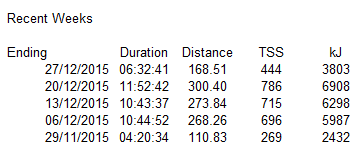
Here are the numbers that created the chart above. You can see my recovery weeks in the last week of November and December. With the ever increasing workload of the Green, Amber and Red weeks.
As we are still in the base period, I like to keep the ramp rate low. I hold it at around five TSS points per week, adjusting my training volume and recovery periods accordingly.
Having been doing this cycling lark for over thirty years, I've got it pretty much sussed now. I'd been doing this for fifteen years previous without software; some still do. And so can you; you don't need a power meter to be able to train in this fashion.
Rule number one; know your body and tune in to it's rhythms. You don't need all this fancy stuff to do it right, just use the software to confirm that you are on the right track.
Once we get to January and the season run-in starts in earnest, I'll ramp up the daily and weekly work rate, and obviously the ramp rate at which the CTL will increase.
The work I've put previous to this point will allow my body to be better able to support a greater workload in the new year. The higher your CTL the more training load your body can "safely" absorb.
Everything has to be progressive and sustainable. If I had tried to apply January's work rate in November, I'd be broken come Easter. The more you've done, the more you can do. The more you've trained in quantity, the harder you can train in quality. It's a virtuous circle.
Which brings us to our final factor for consideration.
Composition...
The Physiological
Continuum
everything you do on your bike fits somewhere on this chart
Composition ~ Quality or Quantity
All of the above factors, TSS (Training Stress Score), ATL (Acute
Training Load), CTL (Chronic Training Load), TSB (Training Stress
Balance), take absolutely no consideration of the quality of
the workouts undertaken.
All we are measuring here, is workload. But there is so much more to getting it right than just workload.
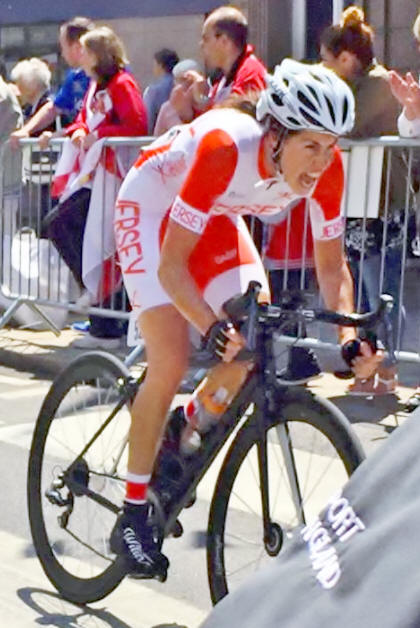
Intensity is everything ~ do it well or don't do
it at all
Clare McGreevy 2015 Island Games
medalist
There is another metric, Intensity Factor (IF) which we mentioned earlier. But this page is getting too big as it is. IF, is basically quality.
As discussed, a one hour flat out (FTP) effort will give a TSS of 100 points. But so does a four hour recovery ride! I know a four hour ride isn't a recovery ride but here's the maths...
Recovery pace is 50% of your FTP wattage/effort. It's also ridden at 50% of the intensity. Half times a half is a quarter; a quarter of 100 is 25. A one hour recovery ride gives 25 points. A four hour one gives 100 points.
Imagine riding as hard as you can, flat out, Zone Four, for one hour every day for a week. Now imagine doing a four hour, Zone One, recovery ride every day.
You will score exactly the same TSS points, and have exactly the same drop in your TSB. But the physiological response from your body will be very, very different.
Numbers mean nothing without context. And this brings me to the inspiration for this factsheet.
One of our riders said that to be "on it" in the middle of the season, his mate told him he had to be at a certain CTL number. I never asked, but most riders aim for a 100. Don't know why, and I suspect, neither do they, they just do!
But what created that "magical" CTL number? You can get there doing purely Zone Two work, but you'll need lots of it. Or you can do it on purely Zone Four Work, obviously you won't need as much, but you'll need a lot more rest. Either approach would be equally disastrous.
To best prepare for a season (or an event), you need to manage the ever-challenging conundrum of the training dichotomy.
The objective is to build your CTL as high as it can practically go, while getting your TSB as close to your positive optimum as you can. While covering all the physiological bases your key objective demands.
Just how hard can it be?
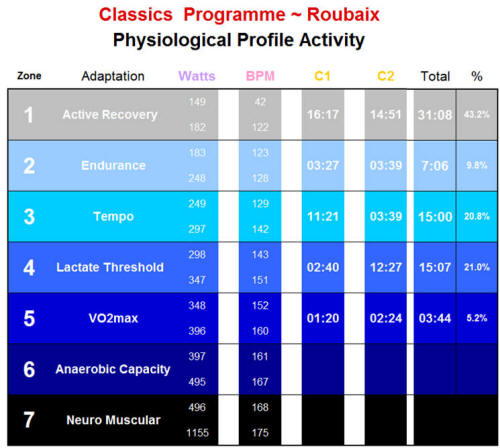
hours spent in each training zone and as a percentage of total time
Roubaix is all about Lactate Tolerance ~ as you can see!
To do this, you need to create (or purchase!) a training programme that best meets the demands of your objective and uses as many and the right proportion, of the relevant seven zones in the physiological continuum.
You have to have the right mix of the requirements and use them in the right order at the right time, to get the right result.
No two events are the same, The physiological demands for the Flanders cyclo are very different to those of Etape Roubaix. Just because they are both cobbled, and around the same distance, does not mean the same programme will work for both events.
Just as no two events are the same, neither are any two athletes. I'll cover the physiological makeup of riders another day.
If you can create a programme that can balance triumph and disaster and treat these two imposters just the same, then you will be...
You will go away for your big day and start with smiles. If you get it right, you'll finish with them as well.
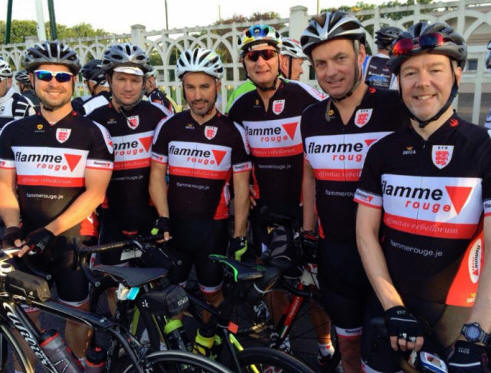
all CTL'd up and ready for the mighty Trois
Ballons
Simon Boyle, Mark Hall, George de Sousa, Me,
Ali Rothwell, Paul Harris
The Message
To create a perfect season, you need perfect preparation.
But none of us live in a perfect world. Our objective is to
get through the winter as best we can and make best use of the
resources we have; be that time, talent or technology.
Everything we do is a compromise. It's the person that compromises the best (not necessarily the least) that is able to triumph and reap the rewards come the big day, by standing on the top step or pulling out a PB.
Learn what works for you. Even if you don't have a power meter, riders managed without them for over a 100 years, you can still make full use of all the information in this factsheet.
Too much workload and not enough recovery means you will, at the most inconvenient point possible, crash and burn.
Too little workload, the wrong workload, or the wrong composition of the right workload, means you will, for very different reasons, reap the "rewards" of a sub-optimal performance.
If you have a power meter, you can now use the information to help you fine tune your input as well as your output. If you don't have a power meter, I'll show you how to work this stuff out in a separate factsheet.
Just try to remember the Seven P's I had drummed in to me during my car racing days. Perfect Planning & Preparation Prevents Pretty Poor Performance. I cleaned it up a bit!
Be Good, Ride Hard, Suffer Well, Recover More...
Foot Note
Finally, here's my "best ever"
TSB fatigue score; minus 80! This is
the day after I did the Mont Ventoux Masters Challenge.
This is what happens when you climb Mont Ventoux five times in one day and hit a TSS of 820 points for just one ride.
Everything after that was downhill...
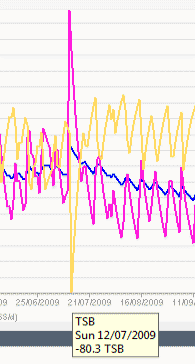
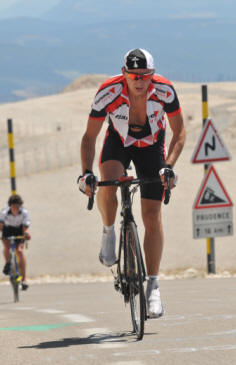
now that was a long, hot, but rewarding, day in the saddle...

